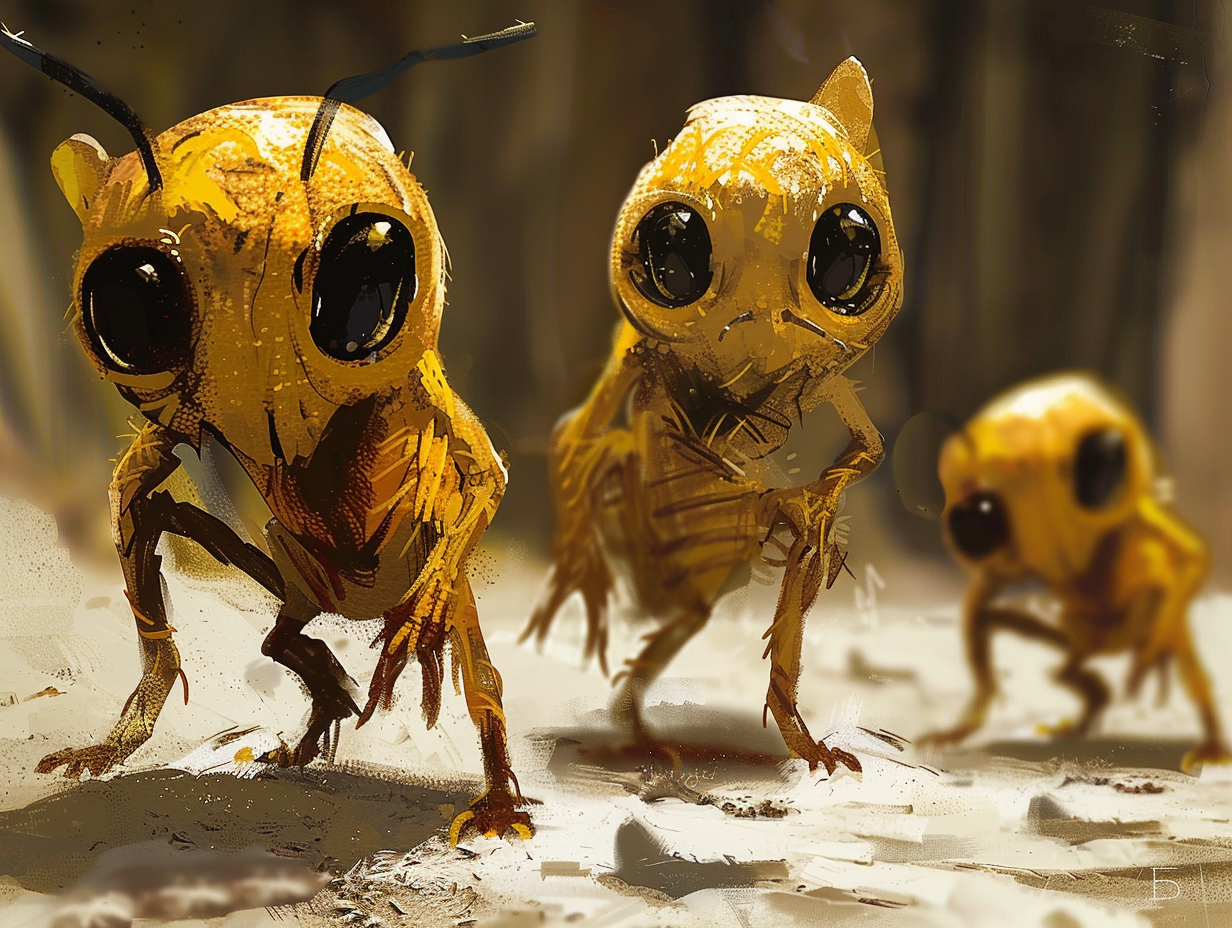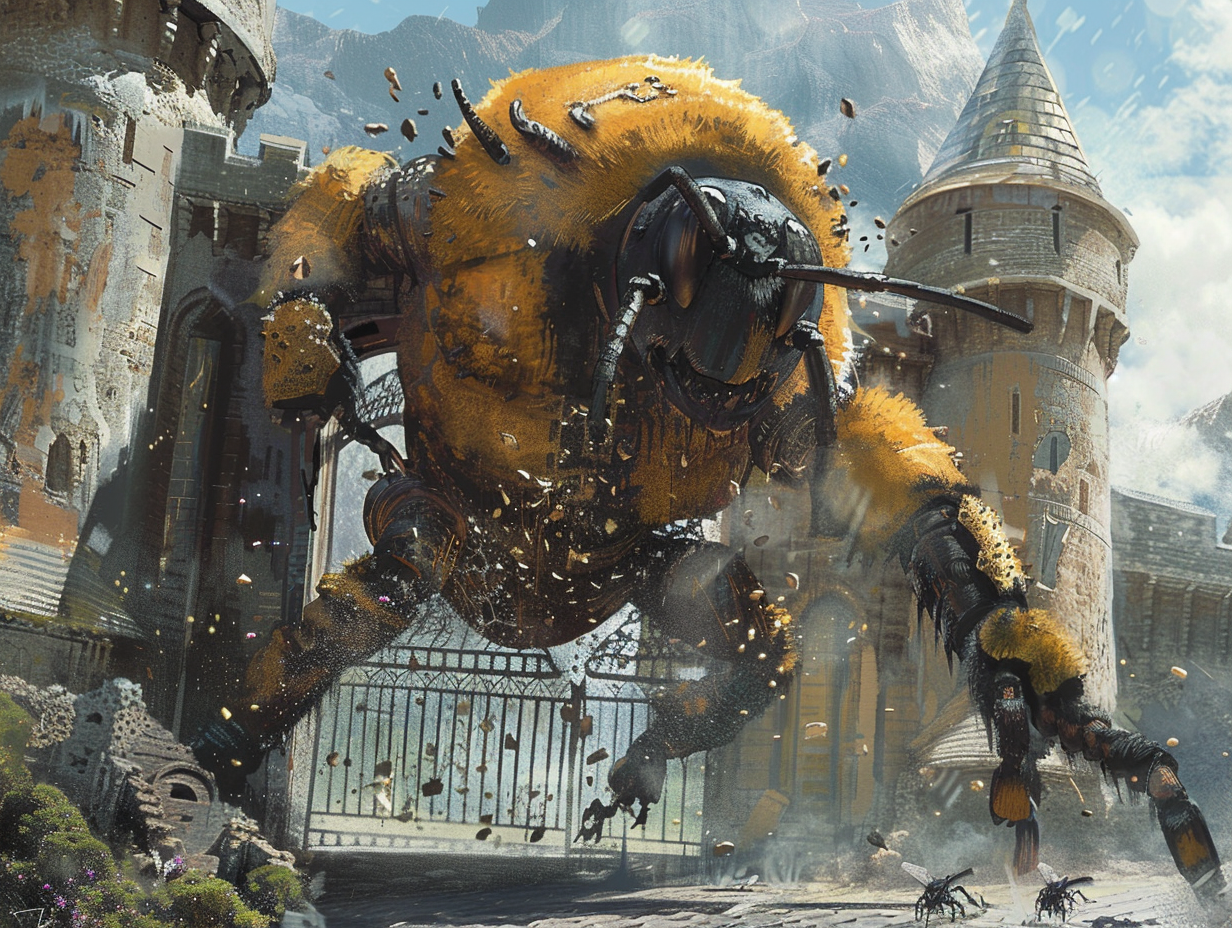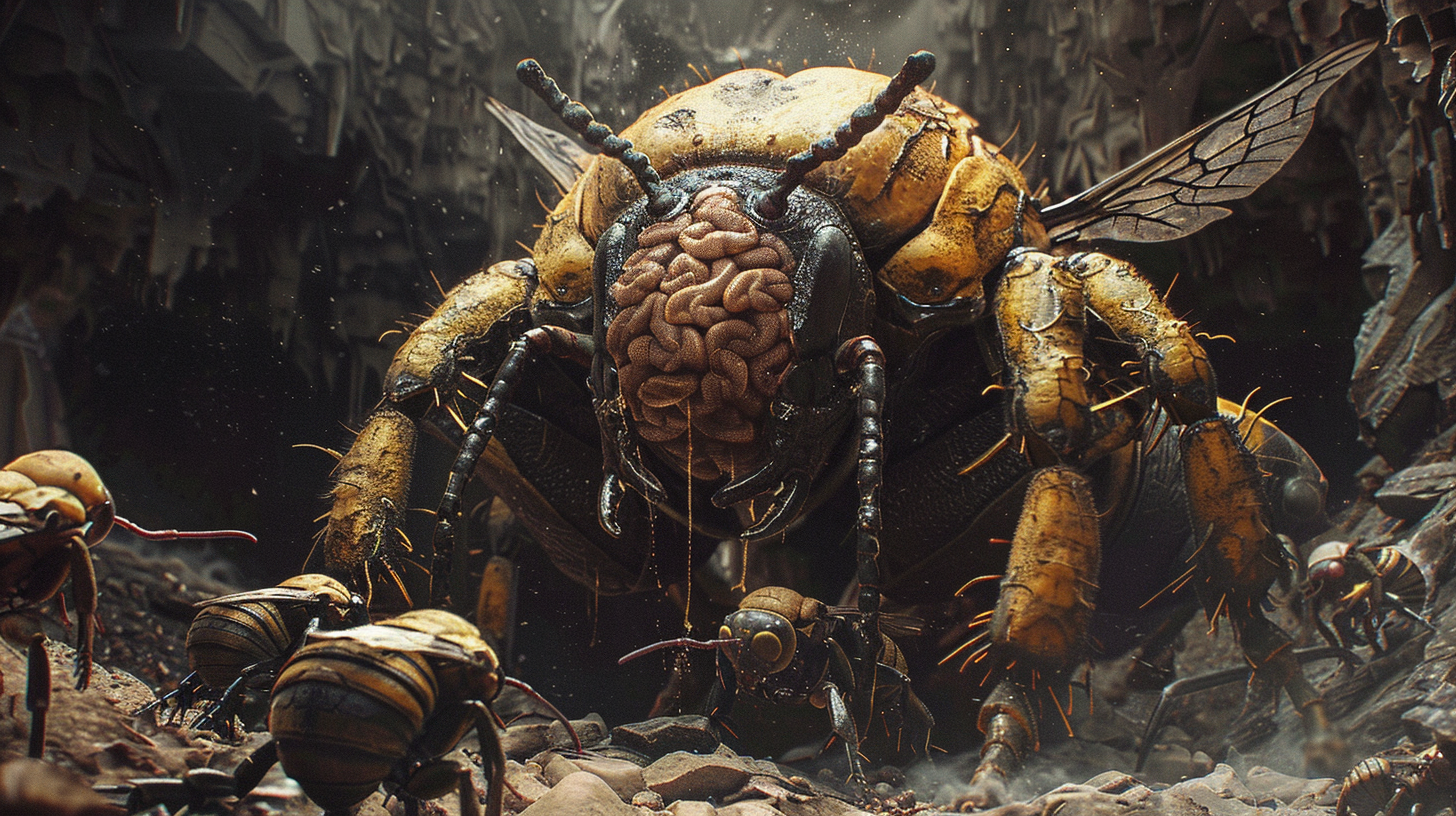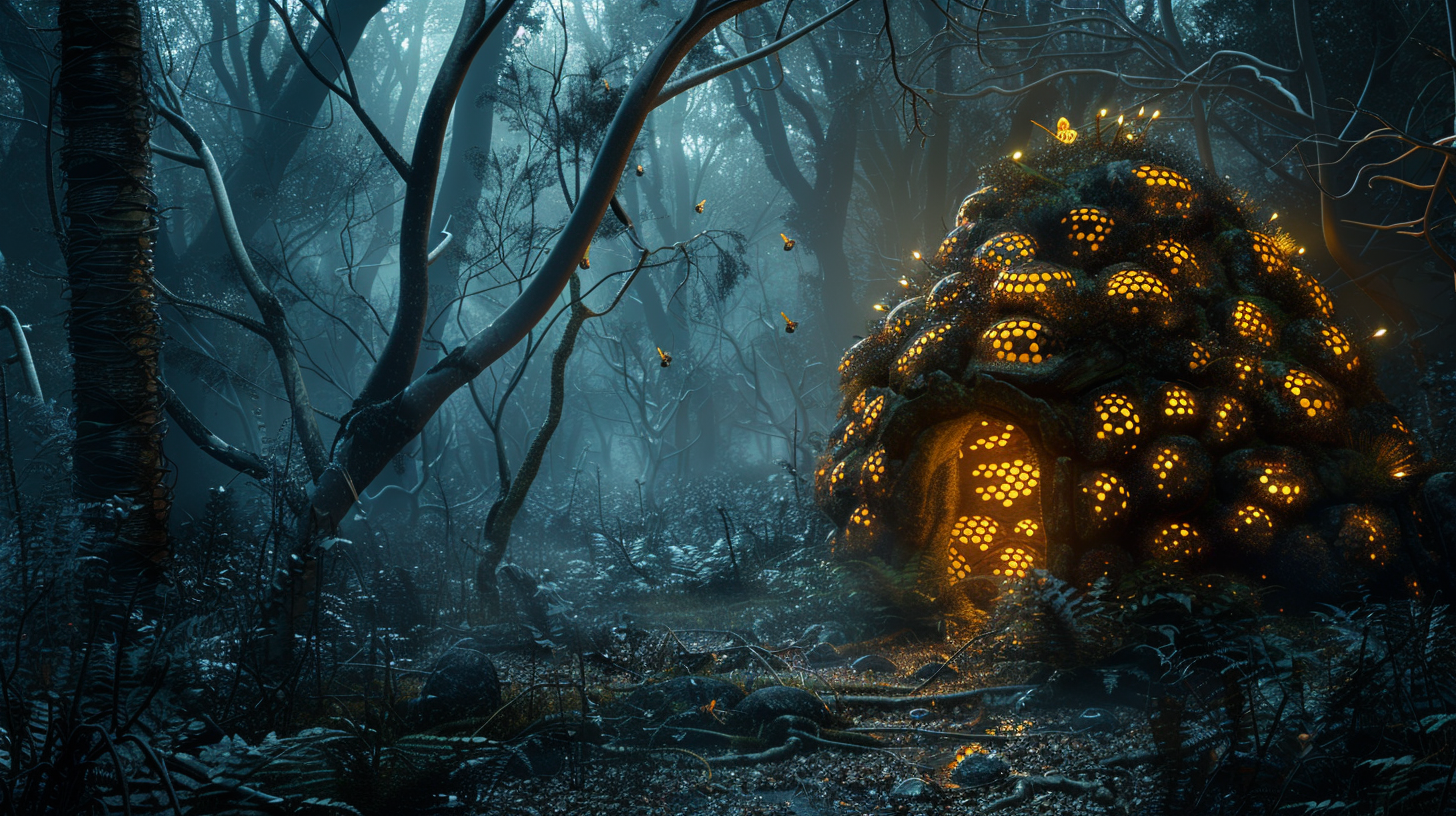Maduka
A plague across central and Southern Legere, the maduka were a species of insect-like humanoids similar to bees or wasps. They were infamous for raiding the countryside, burning farms and stealing from civilizations. Colloquially referred to as "hivemen", they resided in their wax fortresses in forests, vehemently defending their territory while attempting to expand it.
They could become reasonably large threats if allowed to colonize vast stretches of land, and could prove to be a match for even military organizations. They were capable of wielding weapons and had enough intelligence to carry out coordinated attacks. In some cases, hivemen would conduct sieges.
Biology #
Anatomy #
Maduka were short creatures, on average. While some physiological differences were present between different castes, there were several features that were constant. Majority of maduka subtypes had 4 limbs; two arms and two legs. They had a humanoid torso, but with a thinner waist that vaguely resembled the thorax of an insect. They had tough exoskeletons just like their smaller cousins. Their heads possessed two large, glossy compound eyes and a pair of antennae used for smell. The hivemen didn't have mandibles, instead using a jaw with sharp "teeth" all comprised of the exoskeleton.
Colouration of a maduka's body was dependant on its queen--all maduka serving the same queen (aka fellow hive members) had the same colour decals on their exoskeletons. This colour was accented with black striped patterns.
Castes #
There were several different castes of hivemen, each with different roles and capabilities within the hive.
The queen was able to consciously genetically engineer the eggs that she was laying, enabling the queen to reinforce her hive with the specific type of castes she needed.
Drone #
The lowest rung on the ladder of Madukan society, but still well-protected by other members due to their integral role of construction. Drones were short, stout Hivemen who were tasked with the building and repair of strongholds and fortresses. They weren't particularly strong, but were capable of climbing extremely well thanks to their light weight. Drones could secrete wax from their hands, almost like a profuse sweat. This is what let them build with ease. Drones were also responsible for the production of Infernal Honey.
Drones would tend to flee from combat as opposed to rushing into it like many of their siblings.

Squire #
The most common fighting unit in madukan warfare, squires were slightly taller than drones, and had thicker exoskeletons to protect them in battle. Squires were also capable of secreting wax from their hands, allowing them to aid drones in construction when out of combat.
A squire's main role on the battlefield was to be sword-fodder. They weren't exceptionally skilled at fighting, especially since they often wielded stolen tools with varying degrees of combat effectiveness. Squires could also act as forward scouts when attempting to find new territory to colonize.
Bard #
A ranged fighter with the ability to create incredibly annoying noises. Bards were equipped with an elytra that could be vibrated very quickly, creating a buzzing sound. With enough bards, the buzzing sound could cause earsplitting headaches for opponents while fellow maduka weren't affected.
Bards could also secrete wax into special dagger-shaped cavities along their arms and torso, creating sharp spikes which can be used in close combat or thrown at opponents from an alarming distance with surprising accuracy.
Madukan bards were taller than both squires, drones, and knights.
Knight #
The most elite caste of madukan in terms of battle, knights were equipped with a durable exoskeleton and the ability to secrete wax uniformly across their entire body. This coating of wax could get extremely thick, and provided a layer of regenerating armour on top of their already tough natural armour. Knights also had a "mane" of fur around their neck, giving them a much more regal appearance when compared against the lesser castes of hivemen.
Knights coated their arms in wax and sharpened the globs into pointy blades as it dried and hardened. Alternatively, they could fashion other weapons like spears or axes by gluing things together with wax. Knights were genetically predisposed to using weapons, and could prove to be a match against trained combatants from civilized societies.
Cavalier #
 The largest madukan subtype, cavaliers were hulking behemoths only born during times of war. They towered over all their smaller hive members, and their size was accentuated by a dramatic layer of fuzz all over their body. Their exoskeletons were incredibly thick with only a few weak points in non-lethal areas like arm joints. Their heads and necks were also reinforced with more exoskeletal plating. Due to their size, cavalier hivemen required special, large chambers for their eggs to grow in.
The largest madukan subtype, cavaliers were hulking behemoths only born during times of war. They towered over all their smaller hive members, and their size was accentuated by a dramatic layer of fuzz all over their body. Their exoskeletons were incredibly thick with only a few weak points in non-lethal areas like arm joints. Their heads and necks were also reinforced with more exoskeletal plating. Due to their size, cavalier hivemen required special, large chambers for their eggs to grow in.
Cavaliers had massive hands which they used for punching or crushing things. They too can exude wax from their hands, although they preferred to create massive balls of it which they could use to turn their arms into giant maces.
Handmaiden #
Found only in madukan strongholds, the handmaiden caste of hivemen was responsible for aiding the queen in the birthing process. Handmaidens helped feed the queen, as well as transport laid eggs to the right spaces in the birthing chamber. Handmaidens were the only madukan subtype with more than 4 limbs--they had 6 limbs total; 2 legs and 4 arms. This aided them in the carrying of eggs and food.
Handmaidens also acted as bodyguards, staying next to the queen to protect her in case something managed to sneak into the nest. They had incredible strength (which is normally reserved for carrying things) which could make short work of anything in their path. That being said, they are not ideal for a battlefield and instead remain as security.
Handmaidens appeared similar to madukan bards, but with fuzz around their neck and no elytra.
Princess #
Extensions of the queen's will, princesses were bound to their mother by a magical psychic bond. There was one princess for every hive's colonies, and they relayed orders of the queen to and from the workers and soldiers. Princesses appeared similar to knights, but they possessed wings--they are the only madukan subtype with, functional wings rendering them capable of flight. Princesses also had a highly ornamental head, which housed the organs required for long-range magical telepathy.
A new princess was born whenever a preexisting one died or a new colony was founded. The lack of a princess in a colony did not spell immediate doom for its residents, but a prolonged period without a leader would eventually cause the colony to fall into chaos and disarray.
Princesses sometimes entered battle, using their wings and incredible strength, to zip around, lopping off the heads of enemies with their waxy polearms.
Princesses were also key in the succession of a madukan hive's queen. When the current queen died, her consciousness was transferred randomly to one of her daughters. This consciousness melded to princess', which was then compelled to fly back to the palace to begin her transformation into a queen. One could consider the madukan queen to be immortal in a sense, with her consciousness being transferred to countless princesses over the years.
Queen #
 The matriarch and leader of a madukan hive, the hiveman queen was not as elegant or regal as the name suggested.
The matriarch and leader of a madukan hive, the hiveman queen was not as elegant or regal as the name suggested.
Upon arrival at the queen's palace, a newly mentally assimilated princess would psychically initiate a biochemical cascade to alter the body. The princess would first devour the old queen's corpse, supplying the princess' body with the nutrients and protein needed to undergo the transformation process. Once the queen's corpse was fully consumed, the princess took her position in the birthing chamber, where she would never leave again. Over the course of a week, the princess' body would drastically change:
- The princess' abdomen swells before the splitting open the exoskeleton. The fleshy abdomen would protrude from the body and continue to grow in size. This was the queen's birthing tube which she would use to create large batches of eggs.
- The princess' head became swollen as the brain and other magical telepathic organs under the skull grew in size to accommodate the mental strain needed to control the birthing process and relay orders to other princesses. The exoskeletal skull would eventually split open, revealing the squishy brain. Once these two steps ere done, the princess' metamorphosis into a queen was complete.
The queen was not a mobile being at all. With her enormous abdomen and exposed brain, she was in no shape to fight or even move. The queen was relegated to a life of motionless, commanding her maduka from the safety of the innermost sanctum of the hive's stronghold.
Genetics and Reproduction #
Similar to bees, maduka were all the offspring of a queen. The queen could lay up to a hundred eggs per day, depending on how much fresh meat she was supplied with--more food meant more babies. This was one of the reasons why it was dangerous to allow hivemen to roam freely to collect food.
The queen was able to consciously genetically engineer the eggs that she laid, enabling the queen to reinforce her hive with the needed types of castes. The queen never required fertilization from a male.
Madukan offspring were laid as eggs in the wax walls of the queen's birthing chamber. They were continually fed infernal honey until they were large and strong enough to emerge from their chamber by themselves. This period could take as little as 1 week to 1 month, depending on the caste.
Upon the death of the queen, one of the madukan princesses would be psychically "crowned" as a successor.
Dietary Needs and Habits #
All hivemen only needed to consume two things to survive: water and infernal honey. This excluded the queen of the hive, which required more raw protein in order to continue laying eggs. The queen would feed on livestock, wild animals, or any of the sapient races' flesh.
Ecology and Habitats #
Environment #
The hivemen operated in temperate regions--anywhere below the Hydrisikk River was fair game. Any further north and it was too cold. There have been instances of maduka attempting to colonize the north, but the lack of vegetation and low temperatures caused their quick collapse.
As Madukan queens required large amounts of meat to produce young, areas within madukan control often experienced a decrease in the population of large animals.
Madukan Territories: Pseudo Kingdoms #

A small madukan colony built in the forest. The ominous glow of infernal honey illuminates the wax cells in the walls.
The Queen's Palace (Hivemen Stronghold) #
Maduka established kingdom-like territories. At the center of every madukan territory lay the queen's palace, a large stronghold made of madukan wax and reinforced with stones, logs and other available debris. While not always the prettiest to look at, madukan architecture could be breathtaking from size and scale alone. This doubled at night, when the infernal honey filled cells of the hive structure glowed bright against the darkness of the sky.
The destructive potential of fire (which could melt the wax) meant that cells filled with water were also common throughout the structure.
The queen's palace was absolutely crawling with hivemen, and was incredibly dangerous to approach as a non-member of the hive.
Colonies (Hivemen Fortresses) #
Fortresses were slightly smaller scale wax-and-debris structures that served as command nodes for the further expansion of madukan territory. Colonies were led by princesses, often considered to be the "true offspring" of the madukan queen. These princesses could communicate with the queen at long range via a magical connection, carrying out the queen's will and commanding the other madukan hive members in her colony.
Colonies could take around 3 months to build, depending on the amount and proximity of supplies in the surroundings. Once a colony was finished construction, its members would begin to scour the land nearby for places to construct a new colony and thereby expand the hive's territory.
Madukan Territorial Disputes #
As hivemen were highly territorial, even the sight of a different species could whip them into a frenzy. This included maduka from different hives. Massive madukan wars often transpired deep withinin the forest with no one except the madukan belligerents aware of them.
There were 12 different hives of maduka across Legere, and so one could say that there are 12 different madukan "kingdoms".
Each madukan hive was defined by a colour:
- Yellow
- Orange
- Brown
- Bright green
- Pine green
- Pink
- Violet
- Sky blue
- Dark blue
- Red
- Turquoise
- White ^da63ed
Products #
Hivemen produced two highly sought-after substances; Madukan Wax and Infernal Honey.
![[Madukan Wax]]
![[Infernal Honey]]